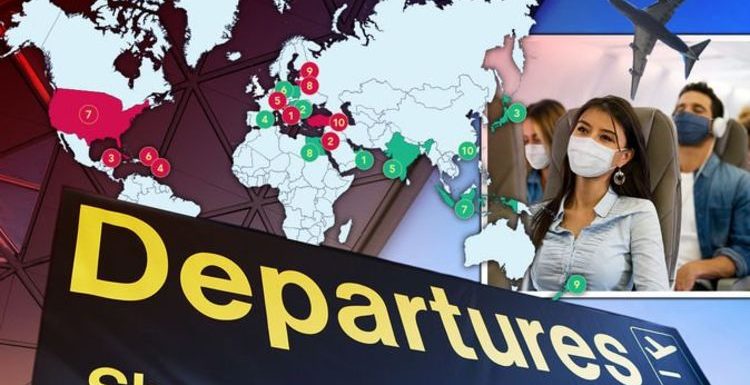
WHO calls for action as Europe coronavirus cases rise
We use your sign-up to provide content in ways you’ve consented to and to improve our understanding of you. This may include adverts from us and 3rd parties based on our understanding. You can unsubscribe at any time. More info
Holidays are already back on for a number of destinations, but from October 4 foreign travel is set to become even easier for fully-vaccinated Britons. However, this doesn’t mean coronavirus has been eliminated worldwide.
In fact, many countries around the world are still grappling with case rates, and the vaccine rollout continues at varying paces.
With countless Britons gearing up to book holidays in the approaching weeks, Express.co.uk has collected some of the latest data on rates of infection around the world to compile the “most” and “least” “Covid-safe” destinations.
Based solely on new daily case rates, Hong Kong comes out as the “safest” destination, with just 0.36 new daily cases per one million of the population, as of September 20.
The nation has also vaccinated over half of its citizens, with 52.86 percent of the destination having received two jabs.

This is followed by New Zealand, where daily case rates are at just 3.79 per one million residents of the country.
However, New Zealand has yet to match the vaccination rate of other global nations.
Just 33.83 percent of the country have received two jabs.
Based on the rate of COVID-19 cases, Egypt is named the third “safest” destination.
According to the data, the country has recorded 5.70 daily cases of coronavirus per one million of the nation.
Despite this, Egypt’s vaccine rollout is lagging far behind some of the most infectious countries in the world.
Indonesia and Poland are considered the fourth and fifth “safest” countries based on Covid cases, with 11.69 and 16.55 new daily cases of COVID-19 per one million people.
While Poland has progressed through its vaccination programme, with 50.92 percent of people having received two doses of the jab, Indonesia trails behind.
There, just 16.36 people have received two COVID-19 injections.
India, Monaco, Japan, Hungary and the United Arab Emirates (UAE) complete the top 10 “safest” destinations based on daily case rates.
DON’T MISS
Most profitable British expat destinations in Europe [DATA]
Flight attendant shares what passengers should never do during Covid [INSIDER]
How Vanlife couple created ‘ideal’ campervan for £7k [INSIGHT]
India is recording just 22.04 per one million confirmed cases of coronavirus daily – however, it is important to note that the nation has vaccinated just 14.76 percent of the population.
Monaco is recording 23.53 cases, with a vaccination rate of 15.81 percent.
Japan is recording 38.76 new cases each day, with a vaccination rate of 54.62 percent.
Hungary is recording 38.94 new cases daily per one million people. Its vaccine rollout has seen 57.91 percent of the nation fully vaccinated.
The UAE is recording 49.83 new daily cases per one million people, however, its vaccination programme has sped ahead – with 80.38 percent of the nation now double-jabbed.
Based on the same data from Our World in Data, Express.co.uk noted the 10 most infectious nations based on new daily cases per one million people.
Montenegro came out as the country posing the “highest risk”, with 982.63 new cases per one million people. Its vaccination rollout has seen 31.42 percent of the population double-jabbed.
Israel and Cuba are also recording high daily cases, with figures of 829.06 and 711.50 respectively.
Israel, however, is one of the most vaccinated nations in the world – 63.60 percent of people in the country have received two coronavirus vaccines.
Cuba has fully vaccinated 39.83 percent of the nation.
Saint Lucia is recording 605.82 new cases of coronavirus per one million people each day. The nation has fully vaccinated 15.82 percent of people.
Slovenia classed as the fifth-highest “risk” based on daily cases, has a figure of 502.52 per one million. It has fully vaccinated 46.73 percent of people.
Antigua and Barbuda, the US and Lithuania are all seeing more than 400 new daily cases per one million of the population.
However, their vaccination rates vary.

In the US, 54.03 percent of the country has received a full course of vaccination. In Lithuania, this figure sits at 60.18 percent. However in Antigua and Barbuda, the figure is just 37.29 percent.
Estonia and Turkey complete the list, recording 351.22 and 322.67 new Covid cases daily per one million people respectively.
Turkey has vaccinated 49.72 percent of the nation, while Estonia has fully vaccinated 44.44 percent.
Though case rates may be high in some countries, it is important to note vaccination alongside this figure.
According to evidence from the National Institute for Health Research: “Vaccination reduces COVID-19 hospital admissions.”
Evidence published in June 2021 from Public Health England showed the Pfizer-BioNTech vaccine is 96 percent effective against hospitalisation after two doses and Oxford-AstraZeneca vaccine is 92 percent effective against hospitalisation after two doses.
According to data from Johns Hopkins University Center for Systems Science and Engineering, as of September 22, 2021, the UK recorded 7,496,547 confirmed cases of coronavirus.
Globally, this makes it the fourth-most infectious country in the world after the US, India and Brazil.
While the UK has one of the highest rates of infection in the world, currently the fifth most infectious country globally, the vaccine rollout in the UK has stormed ahead in equal measure.
As a result, deaths and hospitalisations are now down.
See the latest Covid vaccine stats below and visit InYourArea for all the Covid vaccine latest
How to reduce the risk of Covid while on holiday
Ultimately, when planning a holiday, vaccination and testing remain two of the key ways to reduce the risk of contracting or spreading COVID-19.
Holidaymakers should also apply their usual everyday precautions, including mask-wearing, hand washing and sanitising, and social distancing to reduce the risk of transmission.
Source: Read Full Article









